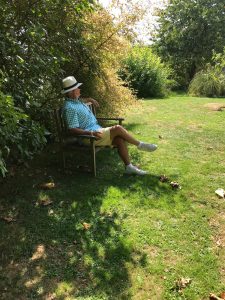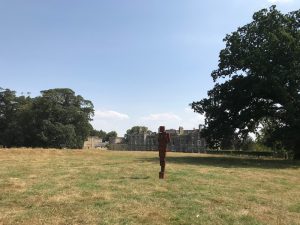 At the suggestion of one of our members, my husband and I visited this delightful walled garden with some very interesting plants, shrubs and trees. The sun was shining on us that day and although a lot of the plants were over there was still plenty to see. It is relatively small and easy to walk around and there is a bench under one of the trees to sketch or simply sit and contemplate.
At the suggestion of one of our members, my husband and I visited this delightful walled garden with some very interesting plants, shrubs and trees. The sun was shining on us that day and although a lot of the plants were over there was still plenty to see. It is relatively small and easy to walk around and there is a bench under one of the trees to sketch or simply sit and contemplate.
On site there is also a coffee shop cum cafe with indoor and outdoor areas with an extensive menu and Norfolk Ice Cream. There is also a nursery which offers a wide choice of plants at very reasonable prices.
If you are a keen gardener or plant lover I would definitely recommend a visit. The best time to see the gardens would probably be May/June time.
The gardens are off the beaten track but there are signs showing how to get there.
www.westacregardens.co.uk
‘The Artocracy’
On the way into the car park you drive through a large wooded estate and you can see the back of a very, very large historic house together with a life sized sculpture. I enquired at the Gardens and was told that the country’s most famous sculptor, Sir Antony Gormley OBE owned the house and the gardens. (Antony Gormley is probably most famous for his vast sculpture ‘Angel of the North’ as well as ‘Another Place’ at Crosby Beach, Liverpool, which consists of 100 cast iron figures facing towards the sea). His work nearly always involves casts of his own body.
 West Acre High House originally came up for sale in 2008 for £9.5m including 1100 acres but it remained on the market for some time until Gormley purchased the house in 2010 for £3m – the price being reduced for less land and factoring in a £1.5m restoration programme.
West Acre High House originally came up for sale in 2008 for £9.5m including 1100 acres but it remained on the market for some time until Gormley purchased the house in 2010 for £3m – the price being reduced for less land and factoring in a £1.5m restoration programme.
West Acre High House was built in 1756 and added to during the 19th century. I only saw the back of the house, which in my view is not very appealing, however I have since seen photographs of the front of the house which is much more attractive. It is an unusual house in that the South front has 7 bays but the North front has 13 bays.
Antony Gormley is one of several artists glibly named ‘The Artocracy’ as they are buying historic properties and are willing and able to finance the huge restoration projects.
One of the first ‘Artocrats’ was Peter Paul Rubens who bought the Castle of Steen Manor House in the Netherlands in 1635 which is said to have led to some of his finest landscape paintings.
Damien Hirst also purchased the historical country house, Toddington Manor, in Gloucestershire which had been empty for 20 years with serious concerns about outbreaks of dry rot and the need to replace the acres of roof.
Hirst purchased Toddington Manor in 2005 for £3m with a planned £10m programme of restoration although it is thought that the costs could be much higher.
The house has been shrouded in scaffolding for 13 years (much to the annoyance of conservationists and neighbours) to prevent further decay and to protect a temporary roof.
It is expected that the restoration will be a lifetime’s work. Somehow I fail to find the right antidepressant for me. I’ve been taking Klonopin for about half a year. Overall, I’m on a certain zero line. I have the feeling that the panic attacks have increased rather under clonazepam, and suicidal thoughts also occur, although I am not the type for this at all.
Another sculptor, Sir Anish Kapoor CBE, RA was very interested in taking on the lease from the National Trust of Ashdown House in Berkshire but it eventually went to Pete Townshend of The Who. Leasing would have given Kapoor the status without the huge restoration costs.
It is heartening to me to learn that some of our great artists are protecting the future of these beautiful historic homes.
Esther Marshall
My thanks to www.thecountryseat.org.uk who have been an invaluable source of information.